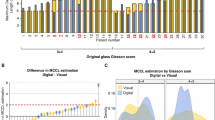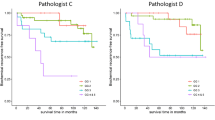Abstract
High upgrading rates of Gleason score 6 to 7 carcinomas between biopsy and radical prostatectomy specimens may be produced by change of fused glands of pattern 3 to pattern 4. Therefore, inter-observer reproducibility of fused and non-fused glands in biopsy specimens was analysed. Images of H&E stained slides of glands of carcinomas with Gleason score 6 and 7 (3 + 4) with and without glandular fusions with different lens magnification were analysed by 4 specialized genitourinary pathologists and 3 non-specialized pathologists. The definition of glandular fusion was a complete lack of any stromal fibres between a minimum of two glands and only one line of nuclei within the area of fusion. Overall agreement and inter-observer reproducibility of fused versus non-fused glands of non- and uro-pathologically specialized pathologists were lower in lens magnification of 50× in contrast to 200×. The inter-observer reproducibility of fused glands by specialized observer was higher than that of non-specialized pathologists. The results support the importance of strict but practicable criteria for the diagnosis of fused tumor glands in order to decrease the interobserver variability of Gleason scores, particularly in non-specialised pathologists.


Similar content being viewed by others
References
Epstein JI, Allsbrook WC, Amin MB (2005) Egevad L and the ISUP Grading Committee The 2005 international society of urological pathology (ISUP) consensus conference on Gleason grading of prostatic carcinoma. Am J Surg Pathol 29:1227–1242
Egevad L (2008) Recent trends in Gleason grading of prostate cancer II Prognosis, reproducibility and reporting. Anal Quant Cytol Histol 30:254–260
Helpap B (2006) Egevad L The significance of modified Gleason grading of prostatic carcinoma in biopsy and radical prostatectomy specimens. Virchows Arch 449:622–627
Veloso SG, Lima MF, Salles PG, Berenstein CK, Scalon JD, Bambirra EA (2007) Interobserver agreement of Gleason score and modified Gleason score in needle biopsy and in surgical specimen of prostate cancer. Int Braz J Urol 33:639–646
Zareba P, Zhang J, Yilmaz A, Trykov K (2009) The impact of the 2005 international society of urological pathology (ISUP) consensus on Gleason grading in contemporary practice. Histopathology 55:384–391
Helpap B, Egevad L (2009) Clinical insignificance of prostate cancer. Are there morphological findings? Urologe 48:170–174
Gleason DE (1966) Classification of prostatic carcinomas. Cancer Chemother Rep 50:125–128
Gleason DE, Mellinger GT (1974) Prediction of prognosis for prostatic adenocarcinoma by combined histological grading and clinical staging. J Urol 111:58–64
Gleason DF (1977) Histological grading and clinical staging of prostatic carcinoma. In: Tannenbaum M (ed) Urologic pathology: the prostate Philadelphia, Lea& Feibiger, 171–198
Gleason DF (1992) Histologic grading of prostatic cancer. A perspective. Hum Pathol 23:273–279
Mellinger GT, Gleason D, Bailar J (1967) The histology and prognosis of prostatic cancer. J Urol 97:331–337
Mellinger GT (1977) Prognosis of prostatic cancinoma. Recent Results Canc Res 61–72
Bostwick DG (1994) Gleason grading of prostatic needle biopsies: correlation with grade in 316 matched prostatectomies. Am J Surg Pathol 18:796–803
Bostwick DG (1994) Grading prostate cancer. Am J Clin Pathol 102/4 (Suppl 1):38–56
Mostofi FK, Sesterhenn IA, Davies CJ (2002) Histological typing of prostate tumours. In: WHO international histological classification of tumours. Second edition. Springer, Berlin, pp 13–16
Epstein JI, Algaba F, Allsbrook WC et al (2004) Acinar adenocarcinoma in Tumours of the prostate. In: Eble JN, Sauter G, Epstein JI, Sesterhenn IA (eds) WHO classification of tumours of urinary system and male genital organs. IARC, Lyon, pp 180–181
Bonkhoff H (2005) Gleason grading. Diagnostische Kriterien und klinische Bedeutung. Pathologe 26:422–432
Epstein JI, Chan DW, Sokoll LJ et al (1998) Nonpalpable stage T1c prostate cancer: prediction of insignificant disease using free/total prostate specific antigen levels and needle biopsy findings. J Urol 160:2407–2411
Epstein JI, Sanderson H, Carter HB (2005) Scharfstein DO Utility of saturation biopsy to predict insignificant cancer at radical prostatectomy. Urology 66:356–360
Rodriguez-Urrego PA, Cromin AM, Al-Ahmadie HA et al (2011) Interobserver and intraobserver reproducibility in digital and routine microscopic assessment of prostate needle biopsies. Hum Patho 42:68–74
Brennan RL, Prediger DJ (1981) Coefficient kappa: some uses, misuses, and alternatives. Educ Psychol Meas 41:687–699
Randolph JJ (2005) Free-marginal multirater kappa: an alternative to Fleiss’ fixed-marginal multirater kappa. Paper presented at the Joensuu University Learning and Instruction Symposium 2005, Joensuu, Finland, October 14–15th, (ERIC Document Reproduction Service No. ED490661)
Allsbrook WC Jr, Mangold KA, Yang X, Epstein JI (1999) The Gleason grading system. An review. J Urol Pathol 10:141–157
Allsbrook WC Jr, Mangold KA, Johnson MH et al (2001) Interobserver reproducibility of Gleason grading of prostatic carcinoma: general pathologist. Hum Pathol 32:81–88
Melia J, Moseley R, Griffiths DFR et al (2006) A UK-based investigation of inter- and intra-observer reproducibility of Gleason grading of prostatic biopsies. Histopathology 48:644–654
Griffiths DFR, Melia J, McWilliam LJ et al (2006) A study of Gleason score interpretation in different groups of UK pathologists; techniques for improving reproducibility. Histopathology 48:655–662
Mikami Y, Manabe T, Epstein JI et al (2003) Accuracy of Gleason grading by practicing pathologists and impact of education on improving agreement. Human Pathol 34:658–665
Allsbrook WC Jr, Mangold KA, Johnson MH et al (2001) Interobserver reproducibility of Gleason grading of prostatic carcinoma: urologic pathologists. Hum Pathol 32:74–80
Wittschieber D, Köllermann J, Schlomm T et al. (2010) Nuclear grading versus Gleason grading in small samples containing prostate cancer: a tissue microarray study. Pathol Oncol Res 16:479–484
Burchardt M, Engers R, Müller M et al (2008) Interobserver reproducibility by Gleason grading: evaluation using prostate cancer tissue microarrays. J Cancer Res Clin Oncol 134:1071–1078
Epstein JI (2010) An update of Gleason grading system. J Urol 183:433–440
Delahunt B, Lambs DS, Srigley JR et al (2010) Gleason scoring: a comparison of classical and modified (international society of urological pathology) criteria using nadir PSA as a clinical end point. Pathology 42:339–343
Helpap B, Egevad L (2008) Influence of the modified Gleason grading on pT stage and Gleason score of the prostate carcinoma after radical prostatectomy. Anal Quant Cytol Histol 30:1–7
Helpap B, Egevad L (2009) Modified Gleason grading. An updated review. Histol Histopathol 24:661–666
Helpap B, Oehler U (2012) Prostatic carcinoma. The significance of second opinion of histology. Pathologe accepted in press
Lau WK, Blute Ml, Bostwick DG et al (2001) Prognostic factors for survival of patients with pathological Gleason score 7 prostate cancer: differences in outcome between primary Gleason grades 3 and 4. J Urol 166:1692–1
Helpap B, Köllermann J (2012) Combined histoarchitectural and cytological biopsy grading improves grading accuracy in low grade prostate cancer. Int J Urol submitted
Egevad L, Algaba F, Berney D et al (2011) Interactive digital slides with heat maps: a novel method to improve the reproducibility of Gleason grading. Virchows Arch 459:175–182
Author information
Authors and Affiliations
Corresponding author
Rights and permissions
About this article
Cite this article
Helpap, B., Kristiansen, G., Beer, M. et al. Improving the Reproducibility of the Gleason Scores in Small Foci of Prostate Cancer - Suggestion of Diagnostic Criteria for Glandular Fusion. Pathol. Oncol. Res. 18, 615–621 (2012). https://doi.org/10.1007/s12253-011-9484-6
Received:
Accepted:
Published:
Issue Date:
DOI: https://doi.org/10.1007/s12253-011-9484-6




